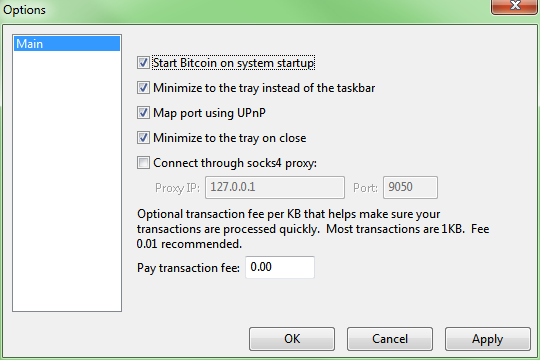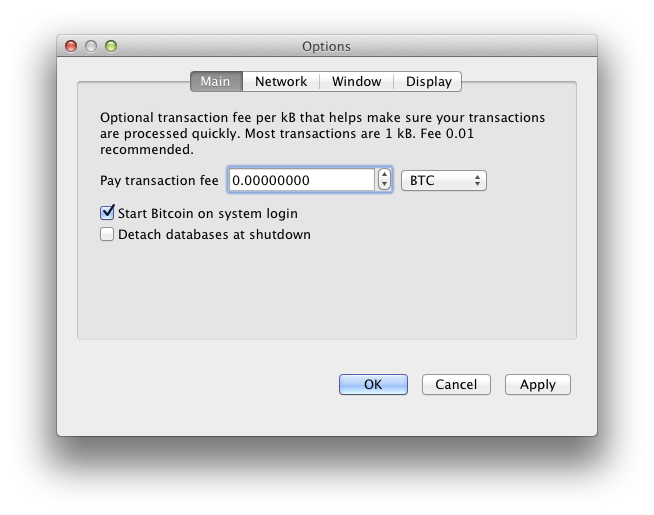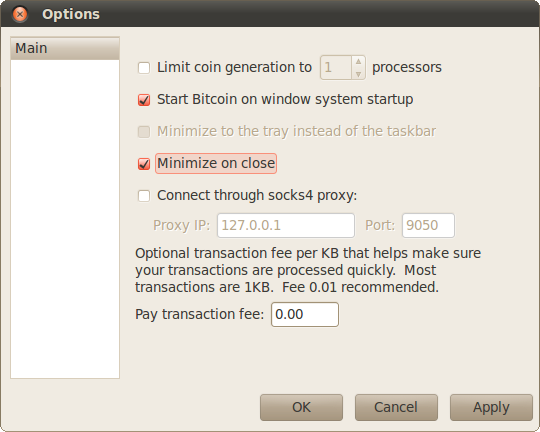|
|
| (43 intermediate revisions by 18 users not shown) |
| Line 2: |
Line 2: |
|
| |
|
| __TOC__ | | __TOC__ |
| ==Command-line arguments==
| |
|
| |
|
| Give Bitcoin (or bitcoind) the -? or –-help argument and it will print out a list of the most commonly used command-line arguments and then exit:
| | ==Linux Quickstart== |
| | |
| | The simplest way to start from scratch with the command line client, automatically syncing blockchain and creating a wallet, is to just run this command (without arguments) from the directory containing your bitcoind binary: |
| | |
| | ./bitcoind |
| | |
| | To run with the standard GUI interface: |
|
| |
|
| Usage:
| | ./bitcoin-qt |
| bitcoind [options] | |
| bitcoind [options] <command> [params] Send command to -server or bitcoind
| |
| bitcoind [options] help List commands
| |
| bitcoind [options] help <command> Get help for a command
| |
| Options:
| |
| -conf=<file> Specify configuration file (default: bitcoin.conf)
| |
| -pid=<file> Specify pid file (default: bitcoind.pid)
| |
| -gen Generate coins
| |
| -gen=0 Don't generate coins
| |
| -datadir=<dir> Specify data directory
| |
| -timeout=<n> Specify connection timeout (in milliseconds)
| |
| -proxy=<ip:port> Connect through socks4 proxy
| |
| -dns Allow DNS lookups for addnode and connect
| |
| -port=<port> Listen for connections on <port> (default: 8333 or testnet: 18333)
| |
| -maxconnections=<n> Maintain at most <n> connections to peers (default: 125)
| |
| -addnode=<ip> Add a node to connect to
| |
| -connect=<ip> Connect only to the specified node at <ip> or <ip:port> (default port: 8333).
| |
| -nolisten Don't accept connections from outside
| |
| -nodnsseed Don't bootstrap list of peers using DNS
| |
| -banscore=<n> Threshold for disconnecting misbehaving peers (default: 100)
| |
| -bantime=<n> Number of seconds to keep misbehaving peers from reconnecting (default: 86400)
| |
| -maxreceivebuffer=<n> Maximum per-connection receive buffer, <n>*1000 bytes (default: 10000)
| |
| -maxsendbuffer=<n> Maximum per-connection send buffer, <n>*1000 bytes (default: 10000)
| |
| -noupnp Don't attempt to use UPnP to map the listening port
| |
| -paytxfee=<amt> Fee per KB to add to transactions you send
| |
| -daemon Run in the background as a daemon and accept commands
| |
| -testnet Use the test network
| |
| -debug Output extra debugging information
| |
| -logtimestamps Prepend debug output with timestamp
| |
| -printtoconsole Send trace/debug info to console instead of debug.log file
| |
| -rpcuser=<user> Username for JSON-RPC connections
| |
| -rpcpassword=<pw> Password for JSON-RPC connections
| |
| -rpcport=<port> Listen for JSON-RPC connections on <port> (default: 8332)
| |
| -rpcallowip=<ip> Allow JSON-RPC connections from specified IP address
| |
| -rpcconnect=<ip> Send commands to node running on <ip> (default: 127.0.0.1)
| |
| -keypool=<n> Set key pool size to <n> (default: 100)
| |
| -rescan Rescan the block chain for missing wallet transactions
| |
|
| |
|
| SSL options: (see the Bitcoin Wiki for SSL setup instructions)
| | ==Command-line arguments== |
| -rpcssl Use OpenSSL (https) for JSON-RPC connections
| |
| -rpcsslcertificatechainfile=<file.cert> Server certificate file (default: server.cert)
| |
| -rpcsslprivatekeyfile=<file.pem> Server private key (default: server.pem)
| |
| -rpcsslciphers=<ciphers> Acceptable ciphers (default: TLSv1+HIGH:!SSLv2:!aNULL:!eNULL:!AH:!3DES:@STRENGTH)
| |
|
| |
|
| Additional (Supported but not listed in -? help):
| | You can get a list of command line options of the version of Bitcoin Core that you are running either in the GUI ("Help" --> "Command-line options") or the daemon ("bitcoind -?"). |
| -min Start minimized
| |
| -checkblocks Rescan the whole blockchain (can take very much time)
| |
|
| |
|
| ==Bitcoin.conf Configuration File== | | ==Bitcoin.conf Configuration File== |
| All command-line options (except for -datadir and -conf) may be specified in a configuration file, and all configuration file options may also be specified on the command line. Command-line options override values set in the configuration file. | | All command-line options (except for -conf) may be specified in a configuration file, and all configuration file options may also be specified on the command line. Command-line options override values set in the configuration file. |
|
| |
|
| The configuration file is a list of setting=value pairs, one per line, with optional comments starting with the '#' character. | | The configuration file is a list of setting=value pairs, one per line, with optional comments starting with the '#' character. |
|
| |
|
| The configuration file is not automatically created; you can create it using your favorite plain-text editor. By default, Bitcoin (or bitcoind) will look for a file named 'bitcoin.conf' in the bitcoin [[data directory]], but both the data directory and the configuration file path may be changed using the -datadir and -conf command-line arguments. | | The configuration file is not automatically created; you can create it using your favorite plain-text editor. A user-friendly configuration file generator is [https://jlopp.github.io/bitcoin-core-config-generator/ available here]. By default, Bitcoin (or bitcoind) will look for a file named 'bitcoin.conf' in the bitcoin [[data directory]], but both the data directory and the configuration file path may be changed using the -datadir and -conf command-line arguments. |
| {| | | {| |
| ! Operating System | | ! Operating System |
| Line 68: |
Line 30: |
| | Windows | | | Windows |
| | %APPDATA%\Bitcoin\ | | | %APPDATA%\Bitcoin\ |
| | (XP) C:\Documents and Settings\username\Application Data\Bitcoin\bitcoin.conf | | | C:\Users\username\AppData\Roaming\Bitcoin\bitcoin.conf |
| (Vista, 7) C:\Users\username\AppData\Roaming\Bitcoin\bitcoin.conf
| |
| |- | | |- |
| | Linux | | | Linux |
| Line 83: |
Line 44: |
|
| |
|
| ==Sample Bitcoin.conf== | | ==Sample Bitcoin.conf== |
| Here is a sample bitcoin.conf file.
| |
|
| |
|
| # bitcoin.conf configuration file. Lines beginning with # are comments.
| | See here https://github.com/bitcoin/bitcoin/blob/master/share/examples/bitcoin.conf |
|
| |
|
| |
| # Network-related settings:
| |
|
| |
| # Run on the test network instead of the real bitcoin network.
| |
| #testnet=0
| |
|
| |
| # Connect via a socks4 proxy
| |
| #proxy=127.0.0.1:9050
| |
|
| |
| ##############################################################
| |
| ## Quick Primer on addnode vs connect ##
| |
| ## Let's say for instance you use addnode=4.2.2.4 ##
| |
| ## addnode will connect you to and tell you about the ##
| |
| ## nodes connected to 4.2.2.4. In addition it will tell ##
| |
| ## the other nodes connected to it that you exist so ##
| |
| ## they can connect to you. ##
| |
| ## connect will not do the above when you 'connect' to it. ##
| |
| ## It will *only* connect you to 4.2.2.4 and no one else.##
| |
| ## ##
| |
| ## So if you're behind a firewall, or have other problems ##
| |
| ## finding nodes, add some using 'addnode'. ##
| |
| ## ##
| |
| ## If you want to stay private, use 'connect' to only ##
| |
| ## connect to "trusted" nodes. ##
| |
| ## ##
| |
| ## If you run multiple nodes on a LAN, there's no need for ##
| |
| ## all of them to open lots of connections. Instead ##
| |
| ## 'connect' them all to one node that is port forwarded ##
| |
| ## and has lots of connections. ##
| |
| ## Thanks goes to [Noodle] on Freenode. ##
| |
| ##############################################################
| |
|
| |
| # Use as many addnode= settings as you like to connect to specific peers
| |
| #addnode=69.164.218.197
| |
| #addnode=10.0.0.2:8333
| |
|
| |
| # ... or use as many connect= settings as you like to connect ONLY
| |
| # to specific peers:
| |
| #connect=69.164.218.197
| |
| #connect=10.0.0.1:8333
| |
|
| |
| # Do not use Internet Relay Chat (irc.lfnet.org #bitcoin channel) to
| |
| # find other peers.
| |
| #noirc=0
| |
|
| |
| # Maximum number of inbound+outbound connections.
| |
| #maxconnections=
| |
|
| |
|
| |
| # JSON-RPC options (for controlling a running Bitcoin/bitcoind process)
| |
|
| |
| # server=1 tells Bitcoin-QT to accept JSON-RPC commands.
| |
| #server=0
| |
|
| |
| # You must set rpcuser and rpcpassword to secure the JSON-RPC api
| |
| #rpcuser=Ulysseys
| |
| #rpcpassword=YourSuperGreatPasswordNumber_DO_NOT_USE_THIS_OR_YOU_WILL_GET_ROBBED_385593
| |
|
| |
| # How many seconds bitcoin will wait for a complete RPC HTTP request.
| |
| # after the HTTP connection is established.
| |
| #rpctimeout=30
| |
|
| |
| # By default, only RPC connections from localhost are allowed. Specify
| |
| # as many rpcallowip= settings as you like to allow connections from
| |
| # other hosts (and you may use * as a wildcard character):
| |
| #rpcallowip=10.1.1.34
| |
| #rpcallowip=192.168.1.*
| |
|
| |
| # Listen for RPC connections on this TCP port:
| |
| #rpcport=8332
| |
|
| |
| # You can use Bitcoin or bitcoind to send commands to Bitcoin/bitcoind
| |
| # running on another host using this option:
| |
| #rpcconnect=127.0.0.1
| |
|
| |
| # Use Secure Sockets Layer (also known as TLS or HTTPS) to communicate
| |
| # with Bitcoin -server or bitcoind
| |
| #rpcssl=1
| |
|
| |
| # OpenSSL settings used when rpcssl=1
| |
| #rpcsslciphers=TLSv1+HIGH:!SSLv2:!aNULL:!eNULL:!AH:!3DES:@STRENGTH
| |
| #rpcsslcertificatechainfile=server.cert
| |
| #rpcsslprivatekeyfile=server.pem
| |
|
| |
|
| |
| # Miscellaneous options
| |
|
| |
| # Set gen=1 to attempt to generate bitcoins
| |
| #gen=0
| |
|
| |
| # Use SSE instructions to try to generate bitcoins faster.
| |
| #4way=1
| |
|
| |
| # Pre-generate this many public/private key pairs, so wallet backups will be valid for
| |
| # both prior transactions and several dozen future transactions.
| |
| #keypool=100
| |
|
| |
| # Pay an optional transaction fee every time you send bitcoins. Transactions with fees
| |
| # are more likely than free transactions to be included in generated blocks, so may
| |
| # be validated sooner.
| |
| #paytxfee=0.00
| |
|
| |
| # Allow direct connections for the 'pay via IP address' feature.
| |
| #allowreceivebyip=1
| |
|
| |
| # User interface options
| |
|
| |
| # Start Bitcoin minimized
| |
| #min=1
| |
|
| |
| # Minimize to the system tray
| |
| #minimizetotray=1
| |
|
| |
|
| ==Platforms== | | ==Platforms== |
| Line 223: |
Line 70: |
| ===Linux=== | | ===Linux=== |
| [[{{ns:file}}:Client_Settings_Options.png]] | | [[{{ns:file}}:Client_Settings_Options.png]] |
| | |
| | ==See Also== |
| | |
| | * [[Data directory]] |
|
| |
|
| [[es:Ejecución de Bitcoin]] | | [[es:Ejecución de Bitcoin]] |
| Line 228: |
Line 79: |
| [[Category:Technical]] | | [[Category:Technical]] |
| [[Category:Developer]] | | [[Category:Developer]] |
| | |
| | {{Bitcoin Core documentation}} |
There are two variations of the original bitcoin program available; one with a graphical user interface (usually referred to as just “Bitcoin”), and a 'headless' version (called bitcoind). They are completely compatible with each other, and take the same command-line arguments, read the same configuration file, and read and write the same data files. You can run one copy of either Bitcoin or bitcoind on your system at a time (if you accidently try to launch another, the copy will let you know that Bitcoin or bitcoind is already running and will exit).
Linux Quickstart
The simplest way to start from scratch with the command line client, automatically syncing blockchain and creating a wallet, is to just run this command (without arguments) from the directory containing your bitcoind binary:
./bitcoind
To run with the standard GUI interface:
./bitcoin-qt
Command-line arguments
You can get a list of command line options of the version of Bitcoin Core that you are running either in the GUI ("Help" --> "Command-line options") or the daemon ("bitcoind -?").
Bitcoin.conf Configuration File
All command-line options (except for -conf) may be specified in a configuration file, and all configuration file options may also be specified on the command line. Command-line options override values set in the configuration file.
The configuration file is a list of setting=value pairs, one per line, with optional comments starting with the '#' character.
The configuration file is not automatically created; you can create it using your favorite plain-text editor. A user-friendly configuration file generator is available here. By default, Bitcoin (or bitcoind) will look for a file named 'bitcoin.conf' in the bitcoin data directory, but both the data directory and the configuration file path may be changed using the -datadir and -conf command-line arguments.
| Operating System
|
Default bitcoin datadir
|
Typical path to configuration file
|
| Windows
|
%APPDATA%\Bitcoin\
|
C:\Users\username\AppData\Roaming\Bitcoin\bitcoin.conf
|
| Linux
|
$HOME/.bitcoin/
|
/home/username/.bitcoin/bitcoin.conf
|
| Mac OSX
|
$HOME/Library/Application Support/Bitcoin/
|
/Users/username/Library/Application Support/Bitcoin/bitcoin.conf
|
Note: if running Bitcoin in testnet mode, the sub-folder "testnet" will be appended to the data directory automatically.
Sample Bitcoin.conf
See here https://github.com/bitcoin/bitcoin/blob/master/share/examples/bitcoin.conf
Platforms
Windows
Start automatically
To configure the Bitcoin client to start automatically:
You might use the configuration-file, or the GUI-Settings:
Settings -> Options
then mark the checkbox titled:
[X] Start Bitcoin on system startup

Batch automation
To work with batch, you have to start the daemon (bitcoind.exe). The bitcoin.exe run with option "-server" will respond with GUI-messages you are not able to process its answers.
Mac

Linux

See Also
|
|---|
| | User documentation | |
|---|
| | Developer documentation | |
|---|
| | History & theory | |
|---|
|


